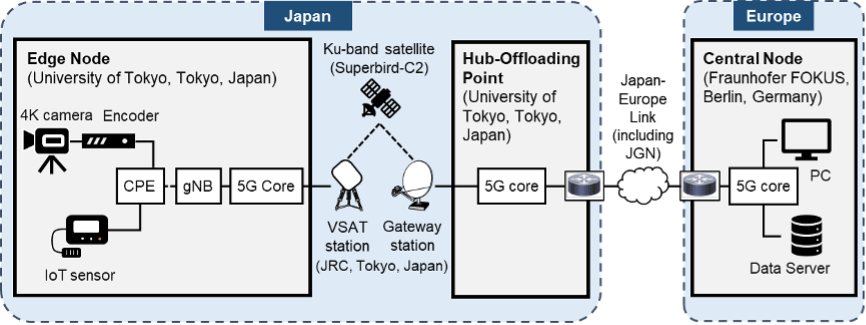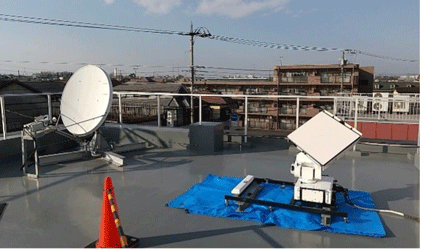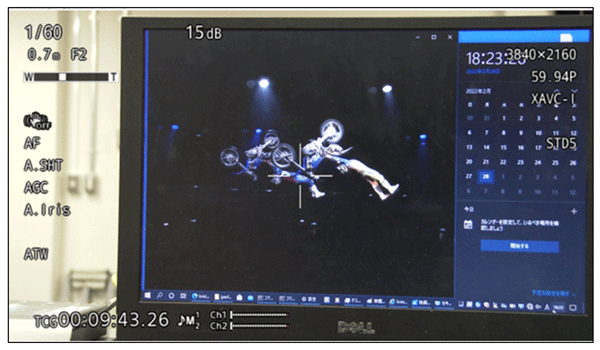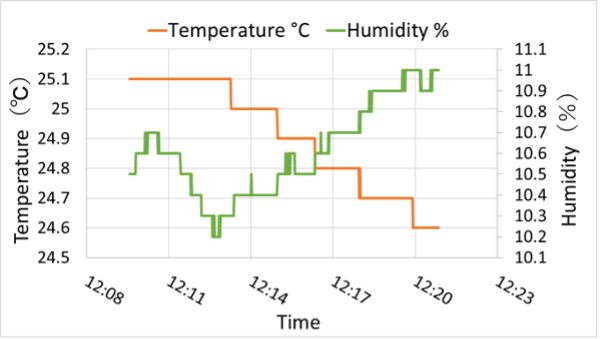Highlights
-
Successful data transmission between Japan and Europe via international 5G communication links including satellite links in a Japan-Europe joint experiment.
-
We demonstrated that satellite links can be utilized in 5G networks over very long distances with high latency.
-
Progress toward realization of Beyond 5G to seamlessly connect between space and terrestrial networks.
Japan Radio Co., Ltd. (Representative Director and President: Takeshi Koarai, hereinafter JRC), SKY Perfect JSAT Corporation (President & Chief Executive Officer: Eiichi Yonekura, hereinafter SKY Perfect JSAT), and the National Institute of Information and Communications Technology (President: Hideyuki Tokuda, Ph.D., hereinafter NICT) jointly worked to conduct a Japan-Europe joint experiment for connecting satellite and 5G, including Japan-Europe long-distance network. Successful transmission of 5G control-plane signal, 4K video, and IoT data was achieved in January and February of 2022 for the first time in Japan. This experiment was conducted in collaboration with the University of Tokyo, School of Engineering, Nakao Research Laboratory, the European Space Agency (ESA), Eurescom GmbH, and Fraunhofer FOKUS Institute. This joint experiment shows that 5G communications can be established over long-distance links between Japan and Europe, including satellite links, and be expected to lead to the early spread of 5G networks in places where 5G deployment has been difficult, such as in the sky, at sea, or on remote islands.
A part of this research’s results was obtained from the commissioned research “Research and Development of Satellite-Terrestrial Integration Technology in Beyond 5G” (No. 21901) by NICT, JAPAN.
Background
In 5G/Beyond 5G, “non-terrestrial networks (NTN)” are attracting attention from the perspective of scalability and a wide range of communication. The NTN is a system that connects different spaces, such as the sea, sky, and space, without barriers via various platforms, such as satellites, high-altitude platform stations (HAPS), and drones. In addition, by connecting NTN and 5G/Beyond 5G terrestrial systems, users will be able to communicate wherever they are. The Third Generation Partnership Project (3GPP) is studying the standardization for the interconnection of NTN and 5G, which is expected to improve performance in conventional use cases and realize new use cases.
Based on this background, NICT and ESA signed and updated a Letter of Intent (LoI) in 2018 and 2020, and planned a joint experiment between Japan and Europe. In this experiment, we aimed to connect satellite links and 5G over long-distance networks to contribute to the realization of 5G/Beyond 5G with long-distance communications between international locations, including communications involving global movement, such as aircraft and international roaming.
Environment of Japan-Europe Joint Experiment
We built a testbed for the Japan-Europe joint experiment connecting the Ku-band satellite (12GHz/14GHz band frequency), local 5G systems, and JGN operated by NICT between Japan and Europe. Figure 1 shows the configuration of the constructed testbed. Figure 2 shows a gateway station and a very small aperture terminal (VSAT) station for the construction of the satellite link. Figure 3 shows the gNB (5G base station) which was used for 5G communications. In this experiment, 4K video and IoT data transmission was conducted as a basic experiment for future international long-distance communications, which targeted the use cases of transmitting video contents and monitoring data obtained in remote areas.

Figure 1: System configuration of the testbed in the Japan-Europe joint experiment.

Figure 2: Gateway station and VSAT station.

Figure 3: gNB (5G base station).
Achievements
We successfully transmitted both 4K video and IoT data using the testbed. In this experiment, we verified that even under the influence of latencies caused by long-distance transmission, including satellite and Japan-Europe terrestrial links, it was possible to establish a communication session using 5G control signals exchanged between the customer-premises equipment (CPE, 5G gateway) in Japan and the 5G core in Europe; subsequently, the data acquired by the 4K camera and IoT sensor in Japan were transmitted to a PC and data server in Europe. Furthermore, we measured the network quality of each transmission segment and evaluated the network performance by connecting satellite links and 5G. Figure 4 shows that the 4K video image was transmitted from Japan to the Europe without any problems. Figure 5 shows a time-series graph of the sensor data acquired in Japan and received by the data server in Europe (in this case, temperature and humidity information). The results of this joint experiment confirmed that the integration of satellite links in 5G networks via international long-distance communication can be realized in terms of specific application transmission.

Figure 4: Transmitted 4K video image.

Figure 5: Transmitted IoT data results.
Future Prospects
It is expected that the technology obtained from this joint experiment will contribute to extending 5G network coverage and constructing a global 5G/Beyond 5G network that includes satellite links.
JRC and SKY Perfect JSAT will continue to cooperate with Europe across borders to establish the technologies necessary for the seamless integration of terrestrial and satellite systems in Beyond 5G.
The NICT will continue to promote international collaboration between Japan and Europe. Furthermore, utilizing the results of this experiment will lead to the development of technology to connect multiple nodes, such as satellites, HAPS, and drones, as well as the realization of a three-dimensional network that connects multiple layers from the terrestrial to the sea, air, and space. The NICT aims to realize diverse communication so that people will communicate in all areas.
Division of roles of each organization for the experiment
JRC:
- Selecting a modem that optimizes each data flow, including 4K video, IoT data, and 5G control signals
- Installation and operation of Gateway station and VSAT station
- IoT data transmission test
SKY Perfect JSAT:
- Installation and operation of Gateway station and VSAT station
- IoT data transmission test
- Providing Ku-band satellite links with Superbird-C2 in geostationary orbit located 144° east
- Evaluation of network performance, such as latency
- 4K video streaming test
NICT:
- Evaluation of network performance, such as latency
- 4K video streaming test
- Planning of Japan-Europe joint experiment with ESA
- Establishment of a testbed for the Japan-Europe joint experiment (5G core software and gNB development)
- Technical support for experiments
Related Link
ESA, Telecommunications and Integrated Applications Directorate (TIA): Space-enabled 5G links forged for the first time between Japan and Europe
URL: https://www.esa.int/Applications/Telecommunications_Integrated_Applications/Space-enabled_5G_links_Japan_and_Europe
URL: https://www.esa.int/Applications/Telecommunications_Integrated_Applications/Space-enabled_5G_links_Japan_and_Europe
Glossary
Eurescom GmbH
A contractor of the European/ESA side. In charge of coordinating the ESA partner organizations in this experiment.
Fraunhofer FOKUS Institute
A contractor of the European/ESA side. In charge of providing 5G core software and satellite edge network development support in this experiment.
3GPP (Third Generation Partnership Project)
A project between standardization bodies to study and develop specifications for mobile phone networks
JGN
A high-speed R&D network testbed for the development of ICT technology operated by NICT. The JGN is designed to provide a testing environment for researchers of advanced networking technologies and to deliver strong support for researchers and empower them.
CPE (Customer Premises Equipment)
Communication equipment used for communication services, such as broadband routers, are installed in subscribers' homes and facilities.
5G core (5G core network)
A part of 5G that handles the connection, routing processes.
Profile of each organization
About Japan Radio Co., Ltd.
With our management philosophy: “We shall deliver excellent value and contribute to a bright future for people, society and the world through wisdom and creativity”, JRC is making the most of its knowledge, technology and experience built up over many years in various fields of information technology, contributing to the safety and security of people around the world.
Website: https://www.jrc.co.jp/eng/index.html
Website: https://www.jrc.co.jp/eng/index.html
About SKY Perfect JSAT
SKY Perfect JSAT Corporation is Asia’s largest satellite operator with a fleet of 16 satellites, and Japan’s only provider of both multi-channel pay TV broadcasting and satellite communications services. SKY Perfect JSAT delivers a broad range of entertainment through the “SKY PerfecTV!” platform, the most extensive in Japan with a total of approximately 3 million subscribers. SKY Perfect JSAT’s satellite communications services, which cover Asia, Indian Ocean, Middle East, Pacific Ocean and North America, play a vital role in supporting communications infrastructures for mobile backhaul, government, aviation, maritime, oil & gas and disaster recovery. For more information, visit our corporate website (https://www.skyperfectjsat.space/en/) and Space Business website (https://www.skyperfectjsat.space/jsat/en/).
About NICT
The National Institute of Information and Communications Technology (NICT) is Japan’s sole National Research and Development Agency specializing in the field of information and communications technology and is charged with promoting the ICT sector as well as research and development in ICT, which drives economic growth and creates an affluent, safe and secure society.
Website: https://www.nict.go.jp/en/
Website: https://www.nict.go.jp/en/
 jrc.co.jp
jrc.co.jp